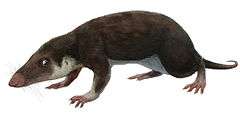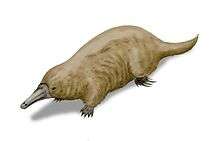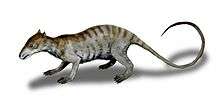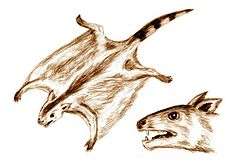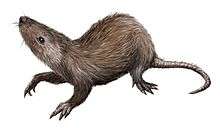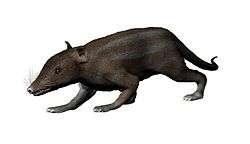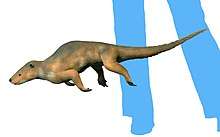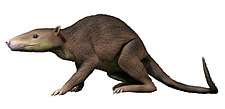Sinodelphys
Sinodelphys is an extinct mammal from the Early Cretaceous. To date, it is the oldest metatherian fossil known,[1] estimated to be 125 million years old. It was discovered and described in 2003 in rocks of the Yixian Formation in Liaoning Province, China, by a team of scientists including Zhe-Xi Luo and John Wible.
| Sinodelphys | |
|---|---|
| Fossil specimen, Hong Kong Science Museum | |
| Scientific classification | |
| Kingdom: | Animalia |
| Phylum: | Chordata |
| Class: | Mammalia |
| Clade: | Marsupialiformes |
| Genus: | †Sinodelphys Luo et al., 2003 |
| Type species | |
| †Sinodelphys szalayi Luo et al., 2003 | |
Fossil record
Only one fossil specimen is known, a slab and counterslab given catalog number CAGS00-IG03. It is in the collection of the Chinese Academy of Geological Sciences.
Sinodelphys szalayi grew only 15 cm (5.9 in) long and possibly weighed about 30 g (1.05 oz). Its fossilized skeleton is surrounded by impressions of fur and soft tissue, thanks to the exceptional sediment that preserves such details. Luo et al. (2003) inferred from the foot structure of Sinodelphys that it was a scansorial tree-dweller, like its non-marsupial contemporary Eomaia and modern opossums such as Didelphis. Sinodelphys probably hunted worms and insects. Most Mesozoic metatherians have been found in North America and Asia. Most lived during the Late Cretaceous between 90 and 66 million years ago.[2]
Evolution of marsupials
Sinodelphys szalayi, living in China around 125 million years ago, is the earliest known metatherian.[2][3][4] This makes it almost contemporary to the eutherian Acristatherium, which has been found in the same area.[5]
| ||||||||||||||||||||||||||||||||||
However, Bi et al. (2018) reinterpreted Sinodelphys as an early member of Eutheria.[6]
See also
References
- O'Leary, M.A.; Bloch, J.I.; Flynn, J.J.; Gaudin, T.J.; Giallombardo, A.; Giannini, N.P.; Goldberg, S.L.; Kraatz, B.P.; Luo, Z.-X.; Meng, J.; Ni, X.; Novacek, M.J.; Perini, F.A.; Randall, Z.S.; Rougier, G.W.; Sargis, E.J.; Silcox, M.T.; Simmons, N.B.; Spaulding, M.; Velazco, P.M.; Weksler, M.; Wible, J.R.; Cirranello, A.L. (2013). "The Placental Mammal Ancestor and the Post–K-Pg Radiation of Placentals". Science. 339 (6120): 662–667. doi:10.1126/science.1229237. PMID 23393258.
- Luo, Zhe-Xi; Ji, Qiang; Wible, John R.; Yuan, Chong-Xi (2003-12-12). "An early Cretaceous tribosphenic mammal and metatherian evolution". Science. 302 (5652): 1934–1940. doi:10.1126/science.1090718. PMID 14671295.
- Rincon, P. Oldest Marsupial Ancestor Found, BBC, December 2003.
- Pickrell, J. Oldest Marsupial Fossil Found in China, National Geographic, December 2003.
- Yaoming Hu, Jin Meng, Chuankui Li & Yuanqing Wang (2010). Xing Xu; Zhe-Xi Luo; Jia-Yu Rong (eds.). "New basal eutherian mammal from the Early Cretaceous Jehol biota, Liaoning, China". Proceedings of the Royal Society B. 277 (1679): 229–236. doi:10.1098/rspb.2009.0203. PMC 2842663. PMID 19419990.CS1 maint: multiple names: authors list (link)
- Shundong Bi; Xiaoting Zheng; Xiaoli Wang; Natalie E. Cignetti; Shiling Yang; John R. Wible (2018). "An Early Cretaceous eutherian and the placental–marsupial dichotomy". Nature. 558 (7710): 390–395. doi:10.1038/s41586-018-0210-3. PMID 29899454.
